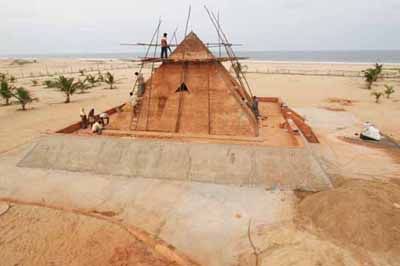Sri Karneshwar Nataraja Temple
Sri Karneshwar Nataraja temple located on the beach at Pudhukuppam, 12 kilometres north of Auroville, was inaugurated by Dr. Karan Singh and his wife Smt. Yasho Rajya Lakshmi on September 30th.
Dr. Karan Singh, Chairman of the Auroville Foundation, being a devotee of Lord Shiva already built in 2000 a smaller temple on the beach near Auroville. The tsunami of 26th December 2004 destroyed it and Dr. Karan Singh asked Satprem Maïni from the Auroville Earth Institute to rebuild a new pyramid temple.
The new temple has been rebuilt on the same place. The Great Pyramid of Egypt is the origin of the concept and the proportions of Sri Karneshwar Nataraja Temple are based on the proportions of this Great Pyramid. The proportions of the latter generate also the pointed dome which houses Lord Nataraja. The pyramid is oriented exactly towards the magnetic North so as to generate its maximum energy.
The dimensions of the temple are based on the significance of numbers as given by The Mother. There are seven steps that lead to the temple, seven being the number which stands for Realisation. Several times the numbers 6 and 14 are found for the dimensions: 6 standing for New Creation and 14 for Transformation. Other numbers are included such as: 3 for Satchitananda and 12 for Double perfection (spiritual and material).
The main material for the dome and the pyramid is compressed stabilised earth blocks (CSEB) and stabilised earth concrete (stabilised with cement). The dome chosen for the temple is a pointed square dome, called cloister dome. Foundations are made with reinforced concrete and they rest 1.15 m below the original ground level, so that no wave may dig them out if another tsunami comes. The basement of the dome, pyramid and the walkway are made of CSEB, which acts as retaining walls for a sand and rubble filling on which the pyramid will rest.
Another reinforced concrete slab links the top part of the retaining walls, where rests the pyramid. All reinforcement bars have been welded together, so as not to create a “Faraday cage effect.” It is well known that this Faraday cage effect disturbs all energies in a building and it was necessary to keep the energy at their maximum. Waterproofing has been done with a cement sand plaster added with a waterproof compound. The pyramid has been covered with over stabilised compressed earth blocks with a mixture of cement, lime and alum.
The main material for the dome and the pyramid is compressed stabilised earth blocks (CSEB) and stabilised earth concrete (stabilised with cement). The dome chosen for the temple is a pointed square dome, called cloister dome. Foundations are made with reinforced concrete and they rest 1.15 m below the original ground level, so that no wave may dig them out if another tsunami comes. The basement of the dome, pyramid and the walkway are made of CSEB, which acts as retaining walls for a sand and rubble filling on which the pyramid will rest.
Another reinforced concrete slab links the top part of the retaining walls, where rests the pyramid. All reinforcement bars have been welded together, so as not to create a “Faraday cage effect.” It is well known that this Faraday cage effect disturbs all energies in a building and it was necessary to keep the energy at their maximum. Waterproofing has been done with a cement sand plaster added with a waterproof compound. The pyramid has been covered with over stabilised compressed earth blocks with a mixture of cement, lime and alum.
Lord Shiva as Nataraja shows us how to be ever in undisturbed peace while we live, move and act. Supported by silence, our work becomes luminous, beautiful and creative. The dance is a creative extension of yogic power. His majestic whirl creates the universe from within his own conscious being, enlivens and beatifies it and fills it with exuberant adventure.
An outer aura of fire represents the sphere of cosmic manifestation, a colossal energizing that arises ultimately from Shivas great concentration. Inside the cosmic circle, as inside our microcosmic selves, is poised the dancing Shiva. In awesome movement, his flying hair bridges the expanse of the fire, stretching from one end of the universe to the other. He is universally present. Around his loins is the skin of a tiger, for he has mastered desire and aggression.
 Dr. karan Singh |
Dr. Karan Singh is the son of the last Maharaja of Kashmir. Building temples is part of his family responsibility. His great-grandfather, Ranhir Singh, who ruled from 1860 to about 1880, has become known as one of the greatest temple builders in Indian history. He built more than a 100 Hindu shrines and temples, mostly in Kashmir. Amongst them is the Raghunath temple, dedicated to Sri Rama, Vishnus eighth incarnation. “We Singhs are descendants of Sri Rama, who is our traditional family deity. The Raghunath temple complex, the largest in North India, houses the samadhis of the Singh dynasty.” says Dr. Karan Singh. “For years, Ive had a vision of building a pyramidal temple dedicated to Lord Nataraja. The pyramid is sacred to the Egyptians and Nataraja to the Hindus. For the first time in history, the pyramid and Nataraja have been brought together. The temple has been constructed mainly for the purpose of Dhyana (meditation) and there will not be many rituals like in other temples” says Dr. Karan Singh. |
 East – West section |  North – South section |






























